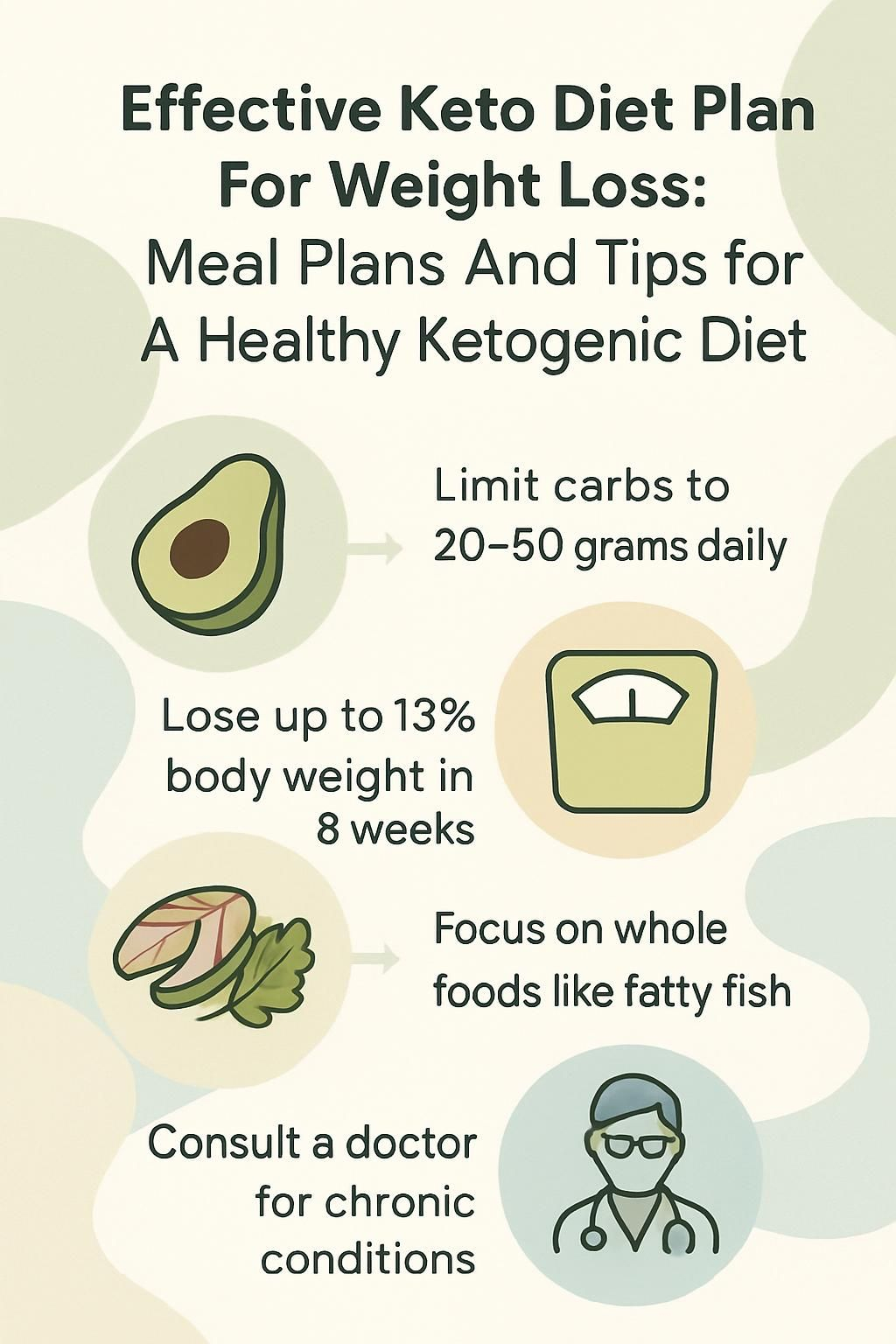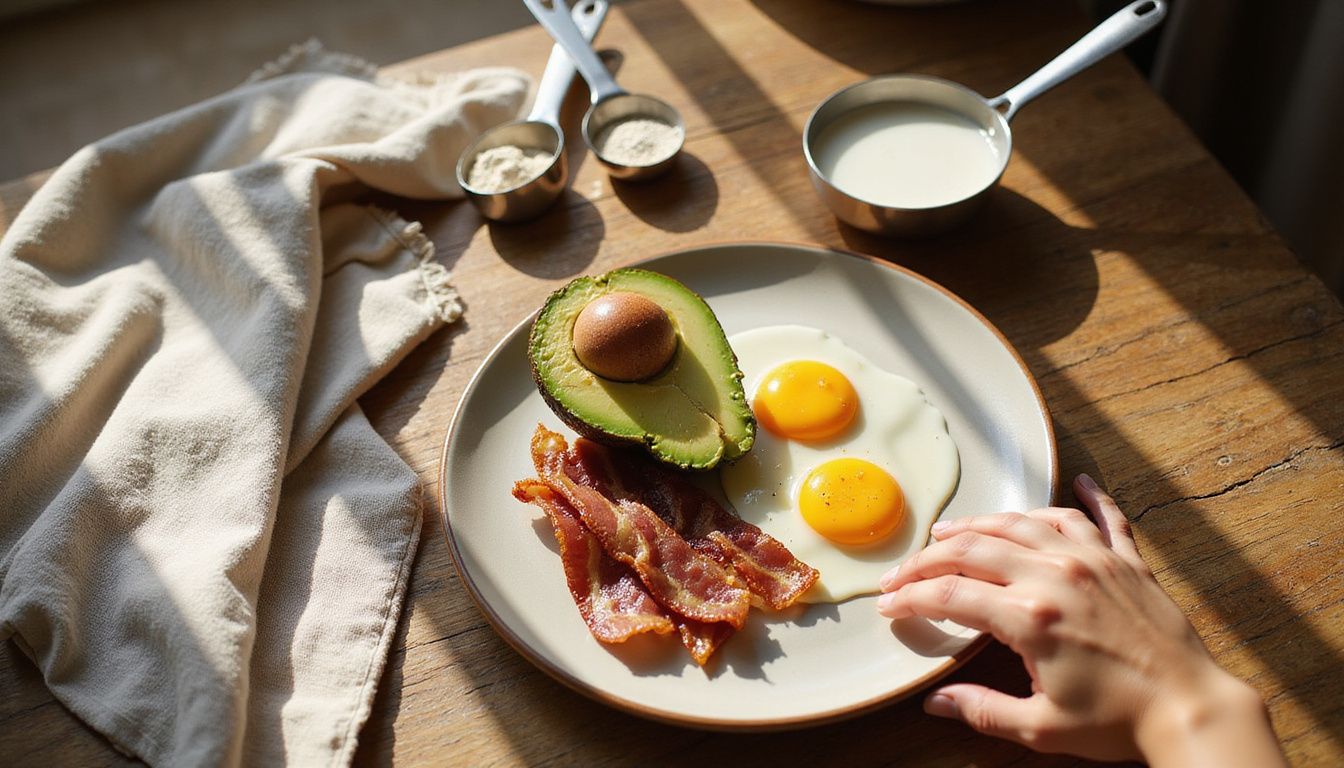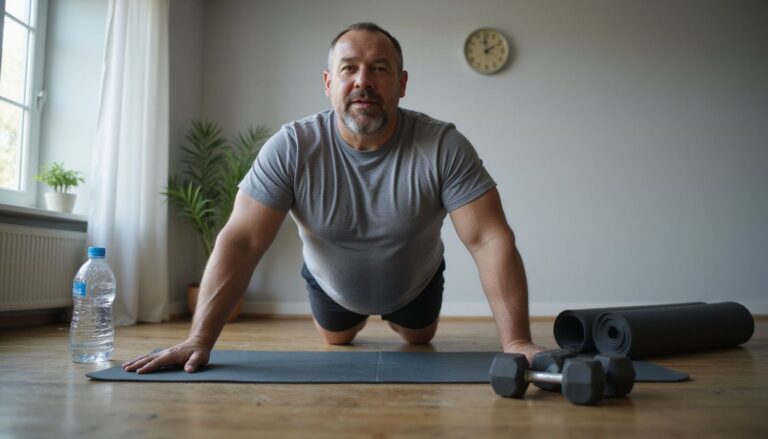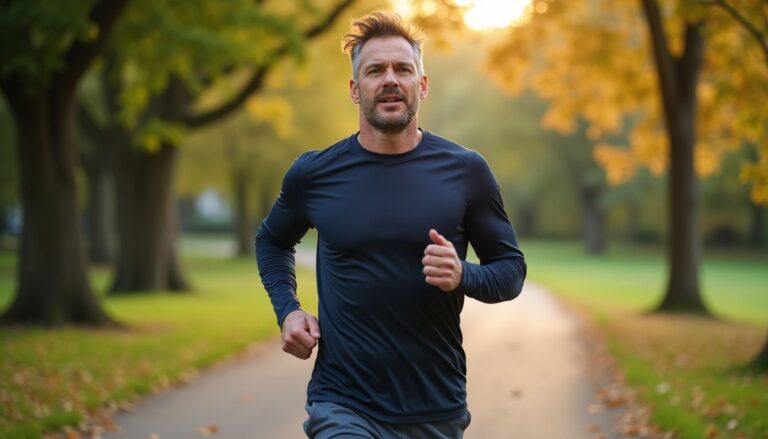Effective Keto Diet Plan For Weight Loss: Meal Plans And Tips For A Healthy Ketogenic Diet
Our Nutrition Assistant AI Suite will transform your body. You will lose fat, get toned, and build muscle. Gain confidence and optimal health.
You may feel stuck if your current diet is not moving the scale. A keto diet plan, which is a high fat and low carbohydrate eating plan, may help your body burn fat for fuel and lose weight at a steady pace.
This guide explains how the ketogenic diet works, what to eat and avoid, a simple weekly meal plan, and smart tips for starting strong. Small changes can add up, and that can make your weight loss less stressful.
Key Takeaways
- The keto diet limits carbs to about 20 to 50 grams per day. This can trigger ketosis, a state where your body burns fat for energy, which supports weight loss (Paoli et al., 2013).
- Research suggests people on keto lose about 2 pounds more than those on low fat plans, and some short trials report up to 13 percent body weight loss in eight weeks.
- Whole foods like fatty fish, nuts, eggs, leafy greens, and healthy oils support ketosis. Grains, sugary drinks, processed foods, and starchy vegetables work against it.
- Many people report better blood sugar control, less hunger, and improved focus. Side effects can occur, such as keto flu and nutrient gaps if you do not plan well.
- Long term safety is not fully known. Talk with your doctor first if you have kidney disease, liver disease, or other chronic conditions.

What Is the Ketogenic Diet and How Does It Work?

A ketogenic diet is a high fat, very low carbohydrate diet that shifts your body into ketosis. Ketosis is a metabolic state where you burn fat, not glucose, as your main fuel. Many people notice weight loss and more stable energy once they adapt.
What Are the Basic Principles of the Keto Diet?
On keto, you eat high fat, moderate protein, and very low carbs. Most people keep carbs near 5 to 10 percent of total calories, which is often below 50 grams per day on a 2,000 calorie diet.
You focus on foods like avocado, olive oil, nuts, fish, eggs, and leafy greens. You skip bread, pasta, and other grains, and you avoid starchy vegetables like potatoes and corn.
A common macro split is 70 to 75 percent of calories from fat, 15 to 20 percent from protein, and 5 to 10 percent from carbs. Net carbs equal total carbs minus fiber and certain sugar alcohols. Some sugar alcohols can still raise blood sugar, so check how you feel after eating them. A simple rule helps many people: eat fat to burn fat, and track your macros to stay on course.
How Does the Keto Diet Promote Weight Loss?
Cutting carbs switches your body from burning glucose to using fat and ketones. This shift can reduce hunger and improve fullness, which makes it easier to eat fewer calories without feeling deprived.
Across multiple trials, keto showed slightly more weight loss than low fat diets after one to two years. In some short studies, participants lost around 10 to 13 percent of body weight in eight weeks to six months, with good adherence rates. Less hunger and steady energy help you follow your plan for the long run.
Benefits of Following a Keto Diet
A keto diet can support weight loss and improve certain health markers. The following sections explain the most common benefits and what they mean for you.
How Does Keto Speed Up Weight Loss?
Keeping carbs under 20 to 50 grams per day encourages your liver to make ketone bodies from fat. This increases fat burning and can reduce belly fat. Studies comparing lower carb diets to low fat diets show greater fat loss and better insulin sensitivity in the lower carb groups.
Lower carb intake can also reduce appetite. Reviews of several trials report less hunger within the first weeks, which makes sticking to your plan easier.
On keto, your body becomes a steady fat burner rather than a sugar burner.
Can Keto Improve Energy Levels?
As you shift into ketosis, your brain and muscles start using ketones, which can provide more stable energy. Many people report fewer afternoon crashes and clearer focus compared to a higher carb diet.
Hydration supports this effect. Plain water or unsweetened coffee and tea work well. Adding mint or lemon peel to water can make it more appealing without carbs.
How Does Keto Regulate Blood Sugar?
Lowering carbs reduces the amount of sugar entering your bloodstream after meals. This helps flatten blood sugar spikes and can improve insulin response. Adults with type 2 diabetes often see better glycemic control on a low carbohydrate, high fat plan compared with higher carb patterns.
Less swing in blood sugar usually means steadier energy and fewer cravings during the day.
What Mental Clarity Benefits Does Keto Provide?
Your brain can use ketones efficiently. Some people notice sharper focus and less brain fog after the first weeks on keto. Early research explores possible benefits for memory and cognition, including in conditions like Alzheimer’s disease.
For example, after switching to more whole foods and healthy fats, I found it easier to focus during afternoon meetings. Short breaks plus a glass of water helped me keep that focus.
Potential Risks of the Keto Diet
The keto diet can cause side effects, especially early on. Knowing the risks helps you prepare and adjust your plan safely.
What Are the Symptoms of Keto Flu?
In the first week, you may feel headache, fatigue, nausea, irritability, or brain fog. Your body is moving from sugar to fat as its main fuel. Some people also notice muscle cramps or trouble sleeping.
These symptoms are usually short term. Drinking more water and adding electrolytes, such as sodium, potassium, and magnesium, can ease the transition.
What Nutritional Deficiencies Might Occur on Keto?
Since keto limits grains, legumes, and some fruits, your intake of fiber and B vitamins can drop. If you do not include leafy greens, seeds, and low carb vegetables, constipation may occur.
You may also get less iron, magnesium, and zinc if your food choices are narrow. These minerals support energy, immunity, and muscle function. A registered dietitian can help you build a complete plan and prevent gaps, especially if you plan to stay on keto for 8 weeks or longer.
What Should You Consider for Long-term Keto Use?
Evidence on long term safety, such as beyond one year, is still limited. People with kidney disease or liver disease should avoid keto unless a clinician closely supervises them. Some people also worry about blood lipids if their diet leans heavily on saturated fat.
A Mediterranean diet pattern can offer similar weight results for some people, while allowing more whole grains and fruit for fiber. If you choose long term keto, track blood pressure, fasting glucose, and lipids with your healthcare provider. Personal goals and medical history matter, so get medical advice before extended use.
Key Components of the Keto Diet
Understanding the core pieces of keto makes planning and shopping easier. Dialing in your macros, or macronutrients, is the first step.
What Is the Macronutrient Breakdown for Keto?
A common target is about 70 to 75 percent of calories from fat, 15 to 20 percent from protein, and 5 to 10 percent from carbs. On a 2,000 calorie plan, that is roughly 165 grams fat, 75 grams protein, and about 40 grams net carbs per day.
Net carbs equal total carbs minus fiber and some sugar alcohols. Tracking intake with an app can help you learn portions and stay consistent during your first month.
Why Is Maintaining Ketosis Important?
Ketosis is the engine for fat loss on a ketogenic diet. Most people stay in ketosis by keeping net carbs below 50 grams per day, and many do better near 20 grams, especially if they have insulin resistance.
Too much protein can be converted into glucose. Aim for moderate protein, not high protein. Careful tracking helps you stay in the sweet spot where ketones fuel your day and hunger stays low.
Best Foods to Eat on a Keto Diet
Nutrient dense foods give you the best results. Build your plate around healthy fats, non starchy vegetables, and quality proteins.
What Are Healthy Fat Sources on Keto?
Use olive oil, avocado oil, sesame oil, butter, and ghee for cooking. Eat avocados often for fat and fiber. Choose nuts and seeds, such as almonds, walnuts, macadamias, pumpkin seeds, and flaxseed.
Unsweetened nut butters can be satisfying snacks. Full fat dairy like plain yogurt, cream, and cheese adds both fat and protein if you tolerate dairy well. Fatty fish such as salmon and mackerel offer omega 3 fats. Beef and pork can help you feel full after meals.
Which Low-carb Vegetables Are Recommended?
Pick non starchy vegetables to keep net carbs low. Leafy greens like spinach, kale, lettuce, bok choy, and chard are great. Cruciferous vegetables, such as broccoli and cauliflower, also fit well.
Other good picks include bell peppers, tomatoes, cucumbers, asparagus, celery, summer squash, onions, and mushrooms. Rotating vegetables keeps meals fresh and helps you meet your fiber goals. Cauliflower rice is an easy swap for regular rice at lunch or dinner.
What Proteins Are Suitable for Keto?
Eggs, chicken, turkey, beef, pork, bison, and organ meats are low in carbs and high in nutrients. Fatty fish like salmon, herring, and mackerel provide omega 3 fats. Shellfish such as shrimp and oysters give you protein and minerals with very few carbs.
If you tolerate dairy, cheeses and plain Greek yogurt can raise protein while helping you stay in ketosis. For vegan keto, choose tofu and small servings of nuts and seeds, then track net carbs closely.
What Are Good Keto-friendly Snacks?
Quick options include hard boiled eggs, cheese, olives, and sliced deli meats without added sugar. Small trail mixes made from nuts and seeds add crunch and fat.
Try coconut chips or kale chips for a crispy bite. Guacamole with celery sticks or lettuce leaves makes a fiber rich snack. Raw broccoli dipped in ranch or sour cream dip is simple and filling.
Foods to Avoid on a Keto Diet
Avoiding high carb foods keeps you in ketosis. Keep this list handy as a shopping check.
Which High-sugar Foods and Drinks Should Be Avoided?
Skip sugar, candy, ice cream, maple syrup, honey, and most desserts. Do not drink regular soda, juice, sweet tea, or sports drinks. These items raise blood sugar fast and can push you out of ketosis.
Watch high carb sauces and dressings. Ketchup and many barbecue sauces contain added sugars. Even a tablespoon can add up and eat into your daily carb limit. Reading labels is a powerful habit.
Why Avoid Grains and Starchy Foods?
Grains and starches are dense sources of carbs. Bread, crackers, cookies, pasta, rice, oats, breakfast cereal, and tortillas can quickly exceed your daily limit. Starchy vegetables such as potatoes, sweet potatoes, corn, peas, and pumpkin also raise carbs fast.
Keeping carbs under about 50 grams per day helps most people stay in ketosis. Swapping oatmeal for eggs or replacing rice with cauliflower rice makes the shift easier.
Reference
1: Paoli A., Rubini A., Volek J.S., Grimaldi K.A.; “Beyond weight loss: a review of the therapeutic uses of very-low-carbohydrate (ketogenic) diets.” European Journal of Clinical Nutrition; July 2013
Which High-carb Fruits Are Not Keto-friendly?
Some fruits are higher in sugar and can disrupt ketosis. Bananas, grapes, oranges, and pineapple top the list. For example, one banana has about 27 grams of carbs, and a cup of grapes has around 26 grams.
Choose berries like strawberries and raspberries more often. A half cup usually has fewer than 8 grams of net carbs, which fits better in a daily plan.
What Processed Foods Should You Skip?
Highly processed foods often include trans fat, added sugars, refined starches, and fillers that add hidden carbs. Avoid fast food pastries, packaged cookies, and snacks made with partially hydrogenated oils. Processed meats that include sugar or starchy fillers can also slow your progress.
Checking labels for added sugar and trans fat helps protect your heart and supports ketosis. Removing these items often improves long term health markers.
Summary Table: Processed Foods to Skip
| Food Type | Why Avoid? |
|---|---|
| Products with trans fat | Linked to higher heart risks |
| Sugar filled sweets | Spike blood sugar, block ketosis |
| Processed meats with sugar | Hidden carbs add up |
| Convenience snack foods | Often contain refined starch and sugar |
Sample Weekly Keto Meal Plan
Use this simple meal plan to lower carbs while keeping meals satisfying. Adjust portions to match your calorie needs.
What Meals Are Recommended for Monday?
Breakfast: Scrambled eggs with sautéed spinach or kale. Add a splash of olive oil for extra fat.
Lunch: Bunless burger with avocado, lettuce, tomato, and pickles. Choose beef or turkey based on your taste.
Dinner: Pork chops seared in olive oil with buttered green beans. Season with salt, pepper, and garlic.
Snack: A handful of almonds or walnuts.
Balanced keto meals can stabilize blood sugar through the day. Some studies note improved insulin response with very low carbohydrate diets within days.[1][1] American Journal of Clinical Nutrition (2020); “Ketogenic Diets: Evidence & Controversies,” 2022
What Meals Are Recommended for Tuesday?
Breakfast: Egg muffins with cheese and spinach, about 2 grams net carbs each.
Lunch: BLTA lettuce wraps, bacon, lettuce, tomato, avocado, and mustard, around 4 grams net carbs.
Dinner: Italian style meatballs with steamed broccoli or sautéed spinach, about 5 grams net carbs per serving.
Snack: A small portion of nuts or a few berries. Vegan keto eaters can use tofu meatballs and dairy free dips.
What Meals Are Recommended for Wednesday?
Breakfast: Veggie scramble with eggs, spinach, mushrooms, and cheese, about 4 grams net carbs.
Lunch: Crispy tuna burgers bound with egg and almond flour, around 8 grams net carbs per serving.
Dinner: Chicken burger patty topped with avocado and greens, no bun, about 4 grams net carbs.
Snack: Almonds or a small handful of blackberries.
What Meals Are Recommended for Thursday?
Breakfast: Cheese omelet, about 5 grams net carbs.
Lunch: Spinach salad with grilled chicken, avocado, walnuts, and olive oil vinaigrette.
Dinner: Baked salmon with roasted asparagus tossed in butter.
Snack: Plain Greek yogurt or a small serving of berries.
What Meals Are Recommended for Friday?
Breakfast: Bacon and eggs, around 2 grams carbs.
Lunch: Garlic steak bite salad with mixed greens, about 6 grams carbs.
Dinner: Seafood chowder with shrimp or white fish, about 6 grams net carbs.
Snack: Nuts, sliced cheese, or a small serving of raspberries.
What Meals Are Recommended for Saturday?
Breakfast: Scrambled eggs with spinach or avocado, about 1 gram net carbs before add ons.
Lunch: Steak bite salad with olive oil and a sprinkle of chopped nuts, around 6 grams net carbs.
Dinner: Creamy crack chicken bowl, about 4 grams net carbs.
Snack: A few blackberries or raspberries.
What Meals Are Recommended for Sunday?
Lunch: Italian meatloaf with pesto mayo, about 4 grams net carbs per serving.
Dinner: Chicken curry bell pepper open faced sandwich, about 3 grams net carbs.
Snack: Tuna avocado salad, about 7 grams net carbs, to stay full between meals.
Choosing the Right Beverages on Keto
Your drink choices matter. Simple options make it easier to stay in ketosis without counting extra carbs.
Is Water and Carbonated Water Allowed on Keto?
Yes. Plain water is best for hydration and appetite control. Aim to sip it through the day.
Unsweetened sparkling water adds fizz with zero carbs. Flavored varieties without sweeteners are fine. This swap alone can reduce cravings for soda.
Can You Drink Unsweetened Coffee and Tea?
Unsweetened coffee and tea are keto friendly. Add a splash of heavy cream for extra fat if you like. Avoid sugar and sweetened creamers, which add carbs.
A cup of black coffee or green tea has almost no calories and no sugar. Many people find these drinks help during fasting windows.
What Are Keto-friendly Drink Alternatives?
Top choices include water, sparkling water, and unsweetened coffee or tea. If you choose alcohol, small servings of dry wine or clear spirits with club soda fit better than sugary cocktails. Keep intake moderate.
Avoid juice, regular soda, and sweet tea. These raise blood sugar quickly and can halt ketosis.
How to Start a Keto Diet Successfully
Starting keto feels easier with a plan. These steps help you reduce carbs, track intake, and stay hydrated.
How Should You Reduce Carbohydrates Gradually?
Track your current daily carbs with an app or food diary. Then lower your intake by 20 to 30 grams per week until you reach 20 to 50 grams per day.
Remove sugary drinks and desserts first. Replace starchy sides like rice with non starchy vegetables such as broccoli, zucchini, or cauliflower rice. Drink more water to ease the transition and reduce keto flu symptoms.
How Do You Track Your Macronutrients?
Use a simple meal plan and a shopping list to stay consistent. A tracking app can calculate calories, fat, protein, and net carbs for each food.
Record your meals daily. Set reminders to log after you eat. Consistent tracking helps prevent carb creep and supports steady progress.
Why Is Hydration and Electrolyte Balance Important?
Lower carb intake reduces insulin, so your kidneys release more water and electrolytes. Without enough fluid and minerals, you might feel headache, fatigue, or cramps.
Drink 2 to 3 liters of water per day, more if you exercise or live in a hot climate. Add sodium, potassium, and magnesium through food or supplements if needed. Signs like dizziness or muscle cramps suggest you need more fluids and electrolytes.
Common Keto Diet Myths Debunked
Misinformation makes keto confusing. Clear facts can help you choose what works for you.
What Are the Misconceptions About Fat Intake?
Many people worry that eating fat always harms heart health. Recent reviews show a more mixed picture, and the type of fat and overall diet pattern matter. Healthy sources like olive oil, avocados, nuts, seeds, eggs, and fatty fish fit well in a balanced keto plan.
For most healthy adults, a mix of saturated and unsaturated fats within calorie needs can be part of a safe plan. Work with your clinician if you have cholesterol concerns or family heart risk.
Are Keto Diets Sustainable Long-term?
Strict diets can be hard to follow for a year or more. Social events and limited options may test your willpower. Nutrient gaps can develop if your food list gets too narrow.
Some people cycle carbs or shift to a Mediterranean style plan after reaching a goal weight. If you stay on keto long term, plan variety, monitor labs, and ask your healthcare provider for guidance.
Frequently Asked Questions About the Keto Diet
These short answers cover common questions about keto and whether it fits your goals.
Is the Keto Diet Suitable for Everyone?
No. People with kidney disease, liver disease, type 1 diabetes, or those who are pregnant, breastfeeding, children, or teens should avoid keto unless a medical professional supervises it. High fat intake can also be risky for some heart conditions.
Check with your doctor before starting if you have any chronic illness or take medications. Safety comes first.
Can Vegetarians Follow a Keto Diet?
Yes, with planning. Lacto ovo vegetarians can use eggs, cheese, plain Greek yogurt, and cream. Dairy free eaters can rely on tofu, tempeh, avocado, coconut products, nuts, and seeds.
Track protein, since many plant proteins include more carbs. During a vegetarian keto month, I prepped spinach omelets, paneer style dishes, and chia puddings to hit my targets.
How Long Does It Take to See Keto Results?
Ketosis can start in 3 to 4 days with strict carb reduction. Early weight loss often comes from water as you use up stored carbs. Some people notice better blood sugar and energy within two weeks.
Over a year, weight loss between diets tends to look more similar. Short term results with keto can be faster, but long term success depends on what you can maintain.
Conclusion
A keto diet plan can help you lose weight and improve blood sugar control. Focus on whole foods, keep carbs low, and use a simple meal plan to reach ketosis. Track your intake, stay hydrated, and include electrolytes to feel your best.
If you have medical conditions, talk with your healthcare provider before starting. With steady habits and the right foods to eat and avoid, you can build a healthy ketogenic diet that fits your life.
FAQs
1. What is the link between a ketogenic diet and Alzheimer’s disease?
Research suggests that a ketogenic diet may help support brain health in people with Alzheimer’s disease. Some studies show that ketones, which are produced during ketosis, can serve as an alternative energy source for brain cells when glucose use is impaired.
2. Can following a keto meal plan aid weight loss while considering risks related to Alzheimer’s disease?
A well-structured keto meal plan can promote weight loss by reducing carbohydrate intake and increasing fat consumption. For those at risk of Alzheimer’s disease, some evidence indicates this approach might also benefit cognitive function; however, long-term effects require more study.
3. Are there specific foods in a healthy ketogenic diet that could impact Alzheimer’s symptoms?
Foods rich in healthy fats such as avocados, nuts, seeds, olive oil, and fatty fish are common in ketogenic diets. These foods provide nutrients linked to better brain function and may help manage symptoms associated with Alzheimer’s disease according to recent clinical trials.
4. How should someone track progress on a keto diet if they have concerns about both weight loss and neurological health like Alzheimer’s?
Tracking daily food intake using nutrition apps or journals helps monitor macronutrient ratios essential for ketosis. Regular check-ins with healthcare professionals allow individuals to assess changes in body composition and cognitive performance over time; this supports safe management of both weight goals and potential impacts on conditions such as Alzheimer’s disease.
Summary:
A ketogenic eating pattern may offer benefits for both weight control and neurological health including possible positive effects for those concerned about Alzheimer’s disease. Choosing nutrient-dense foods high in healthy fats supports these outcomes best when paired with regular monitoring under medical guidance.







